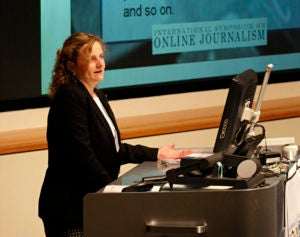April 18, 2009 | Citizen Journalism, Research
Citizen Journalism, User-Generated Content and Crowdsourcing

The second panel of Saturday’s ISOJ covered “Citizen Journalism, User-Generated Content and Crowdsourcing: Who is Contributing to the Conversation and Why?” Academics from all over the United States and the world contributed information they had gathered on user interaction and how it affects journalism. User-generated content, or UGC, has been an interesting issue for online journalism.Cindy Royal, an assistant professor at Texas State University at San Marcos, moderated the discussion. She put forth the question, “Why do we spend all this time communicating online without any expectation?” Many journalists are capitalizing on the audience’s enthusiasm to participate.
New technology has also changed user-generated content. Royal showed through her twitter account that audience feedback could be a great source of information. Fifteen minutes before the presentation she asked the twitter universe for some examples on why we use social media. The quick and thorough response from users is an example in itself of why social media is beneficial.
The first presentation by Na’ama Nagar of University at Albany-SUNY discussed “The Loud Public: Readers’ Comments in Online News Media.” Although a political scientist and not a journalist, her research looked at comments on news websites in both the U.K. and Israel. She took a look at how comments are controlled and how they influence editorial decisions. There are many levels of user interaction in the talk back feature of news websites. The anonymity of users can vary and the quality of feedback can change from one website to another.
Nagar also witnessed user comments influencing agenda building within news organizations. Some journalists are asked by their editors to follow up on a story that received a lot of feedback from users. Some stories are also written because they will stir debate among the audience. Nagar said, “Users do not dictate messages but they are one of the forces that have some influence.”
Two professors from the University of Texas were next to present. “Thinking about Citizen Journalism: Perspectives on Participatory News Production at Community Newspapers” was discussed by Seth C. Lewis and Kelly Kaufhold. Dominic L. Lasorsa, also of UT Austin, contributed to this research. Their work looked at local Texas publications and how the editors perceived user generated content. Citizen journalism at smaller newspapers was a place to start looking at the gatekeeping authority of journalists. They found that both philosophical and practical issues contribute to editors’ opinions.
Lewis said, “In the last few years newspapers are not trying to be on the web but of the web.” Smaller papers, which are typically behind the curve on technology, are beginning to adopt the ideas of user-generated content. Their findings show that these papers have negative or positive attitudes about citizen journalism based on their size, needs, and experience with it in the past. Some use citizen journalists to supplement their reporting while others did not want to hand over their job to untrained citizens. Their research provides an interesting look at journalists’ opinions on citizen journalism at smaller newspapers.
Elvira García de Torres from Universidad CEU Cardenal Herrera in Spain presented her collaborative work “UGC Status and Levels of Control in Argentine, Colombian, Mexican, Peruvian, Portuguese, Spanish, US and Venezuelan Online Newspapers.” She worked with academics from all over the world to compile an analysis of online newspapers in these areas. She discussed how participatory journalism affects the relationship between the journalist and the reader. The user and producer have a unique relationship that can be defined through user feedback. Twenty-four websites were surveyed on how they use user-generated content. A variety of factors are important in their analysis including the circulation, the content license, rules, ease of use, and whether a user has to pay. They developed many conclusions about a user’s role in online journalism based on their findings.
The final presentation, “When the Crowd Doesn’t See the Value: Crowdsourcing, Citizen Journalism, and the Cultural Production of Local Online News” was based on Shayla Thiel-Stern’s study of two websites in the Minneapolis area. Thiel-Stern is from the University of Minnesota, Minneapolis. She looked at both the Twin Cities Daily Planet and Locally Grown Northfield. Although her research is still a work in progress, she has found some interesting results at these small community websites. Both utilize user-generated content and are funded by grants and reader donations.
Locally Grown Northfield is especially interesting because they hired a trained reporter to come in and cover community issues. Thiel-Stern found that the reporting was very transparent and relied on audience feedback. The community members who participated did not see the value in their own interaction. They dismissed their significance even though the editor and reporter both recognized their relevance.
ISOJ 2009: Citizen Journalism panel, from Knight Center on Vimeo.

